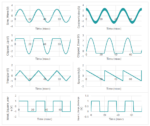You are currently viewing SemiWiki as a guest which gives you limited access to the site. To view blog comments and experience other SemiWiki features you must be a registered member. Registration is fast, simple, and absolutely free so please,
join our community today!
This webinar introduces Questa One Sim CX, an innovative coverage-driven simulation solution that revolutionizes SystemVerilog UVM verification workflows.
Traditional coverage closure methods, relying on constrained-random stimulus generation and iterative manual adjustments, often prove time-consuming and resource-intensive.
…
Read More
LLMs are already simplifying assertion generation but still depend on human-generated natural language prompts. Can LLMs go further, drawing semantic guidance from the RTL and domain-specific training? Paul Cunningham (GM, Verification at Cadence), Raúl Camposano (Silicon Catalyst, entrepreneur, former Synopsys CTO… Read More
We have been hearing so much lately about the power of AI and the potential of technologies like agentic AI to address the productivity gap and complexities of semiconductor designs of today and tomorrow. Currently, however, the semiconductor industry has been slow to adopt generative and agentic AI for RTL design code. There… Read More
Badru Agarwala is the CEO and Co-Founder of Rise Design Automation (RDA), an EDA startup with a mission to drive a fundamental shift-left in semiconductor design, verification, and implementation by raising abstraction beyond RTL With over 40 years of experience in EDA, Badru served as General Manager of the CSD division at… Read More
Tell us a little bit about yourself and your company, AMIQ EDA.
We are an EDA company providing software tools targeting both chip design and chip verification. Our tools enable engineers to increase the speed and quality of new code development, simplify debugging and legacy code maintenance, accelerate language and methodology… Read More
You begin writing some UVM code and there are parts of the code that aren’t done yet, so you begin to use uvm_objection, guarding that code. Rich Edelman, a product engineer at Siemens doing verification debug and analysis, wrote a paper on this topic, which I just read. This blog covers the topic of objections and provides some different… Read More
I’ve been working with AMIQ EDA for several years, and have frequently been impressed by new capabilities in their Design and Verification Tools Integrated Development Environment (DVT IDE) family. They just announced AI Assistant, which leverages large language model (LLM) technology. LLMs are much in the news these days,… Read More
Functional coverage acts as a guide to direct verification resources by identifying the tested and untested portions of a design. Functional coverage is a user-defined metric that assesses the extent to which the design specification, as listed by the test plan’s features, has been used. It can be used to estimate the presence… Read More
I stopped by the AMIQ EDA booth at DAC to get an update from Tom Anderson about their Integrated Development Environment (IDE), aimed at helping design and verification engineers save time. In my early IC design days we used either vi or emacs and were happy with having a somewhat smart text editor. With an IDE you get a whole new way … Read More
Transistor-level circuit designers have long used SPICE for circuit simulation, mostly because it is silicon accurate and helps them to predict the function, timing, power, waveforms, slopes and delays in a cell before fabrication. RTL designers use digital simulators that have a huge capacity but are lacking analog modeling.… Read More










